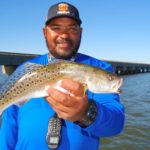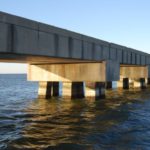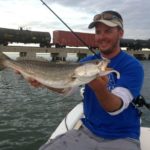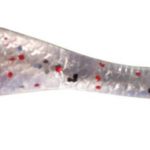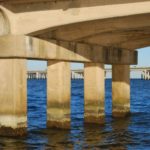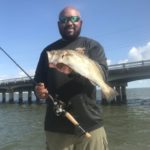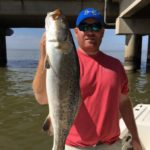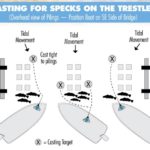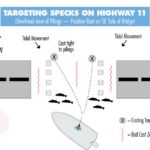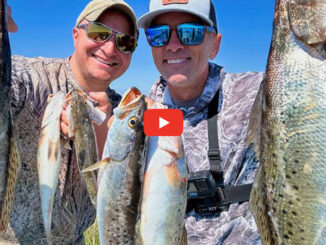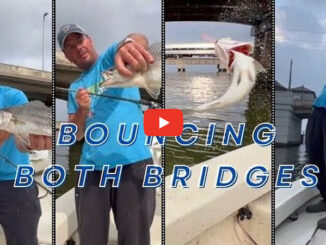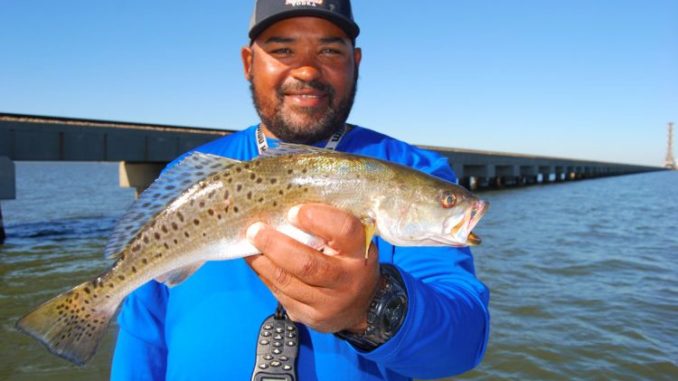
Lake Pontchartrain is where many a speckled trout angler’s dreams of limits go to die. Fish are there this month, but the bite can be finicky — and knowing subtle nuances and being able to read conditions are keys to success.
As December rolls around — and lots of Lake Pontchartrain anglers are in deer stands and duck blinds pondering awkward office Christmas parties, lame bowl game matchups and how much fried turkey they can consume in the coming weeks — Capt. Kris Robert stays laser-focused on what he does for pretty much the other 11 months of the year.
The 43-year-old Slidell guide with One Last Cast Charters is busy tracking down speckled trout in and around Lake Pontchartrain for him and his clients.
And while the lake is still known for sporadically producing big specks, as well as solid numbers of trout during the “World Series Run” every fall, the final month of the year presents some challenges.
“The December bite can be tricky because it all depends on what’s happening with the weather,” Robert said, lamenting both the closure of the Mississippi River Gulf Outlet and the revamped levee system on the Pearl River as two key reasons why the estuary is less salty and more fresh than it used to be. “That’s why you’re not seeing the big ones …. And in previous years when the ‘World Series Trout’ was going on, we were getting cold fronts in the beginning of October — so by the time the end of the month came around and the World Series started, the water temperature had already dipped down to the low 70s and high 60s, and the trout were already there.”
Robert said water temperature in the lake is key on when speckled trout actually start stacking up on Pontchartrain’s bridges in the fall, including the Causeway, as well as the Trestles, Highway 11 and the I-10 Twin Span on the east end.
“Cooler water temperatures force the white shrimp out of the lake, so a trout’s diet changes,” Robert explained. “They’re trying to bulk up for the winter and the shrimp leave, so now it consists of finfish like pogies and shad that are full of oil and protein.
“The trout just sit behind the bridges ambushing the finfish.”
Robert agreed to breakdown details of the bite at three December hotspots: the Trestles, Highway 11 and the Causeway, so maybe you can enjoy some speckled trout fillets with all that fried turkey later this month.
Rigging up for deepwater jigging
For each of the bridges, Robert keeps things pretty simple: His method of attack is deepwater jigging, and depending on the current, he usually favors a ⅜-ounce jighead along with Matrix Shad soft plastic paddletail lures in shrimp creole, lemonhead, ultraviolet or magneto.
“I don’t know what the attraction to lemonhead is, but they sure like it in the wintertime,” Robert laughed, commenting on the bright yellow lure that definitely doesn’t look like anything natural in the lake. “You know what I think it is? They’re trying to just gorge themselves, so anything they see come by they’re going to eat because it’s swimming like a fish.”
Robert is a jigging maestro, effortlessly placing the lure in the exact spot he’s aiming for near a bridge piling. He casts out, then waits several seconds for the Matrix Shad to swim to the bottom before cranking the reel and sharply popping his rod up three or four times — POP-POP-POP-POP. He reels in some slack as he jigs, but always keeps his index finger positioned on his baitcaster to monitor for a bite even when the line is slack.
He said he was fishing slower than in the spring, but you could have fooled me.
“I’m not popping it up as high. I’m trying to keep it in the strike zone,” he said. “Maybe a couple inches off the bottom, like you’re dead-sticking a worm. In the spring, I’ll jig it fast. But in the fall, I”ll kind of slow it down a little bit because they’re lethargic.”
He uses 17-pound Matrix mono line and favors a 6-foot, 8-inch medium action rod to set the hook and still have enough muscle to pull lunker trout out of the pilings before they break off.
Tide-wise, he favors an outgoing tide in the fall, so he’ll typically position his boat on the south side of the Trestles and the Highway 11 bridge and cast into the structure, to simulate bait being swept out of the lake with the tide.
The Trestles
The 5.8-mile Norfolk Southern rail line connecting Slidell and New Orleans is the longest railroad bridge in the United States, possibly the world. Locally, it’s known as the Trestles, and it can feel like it’s 55 miles long when the specks aren’t biting.
“The Trestles is the most popular bridge to fish along with the Causeway,” Robert said. “The thing to remember there is the fish could be anywhere from right on the pilings to 5 feet off the piling, or maybe 30 feet off the bridge closer to the boat.”
The bridge supports at the Trestles are each composed of two adjacent rows made up of three square concrete pilings, and casting sidearm is a must because of the low clearance.
“You want to cast as far past the back piling as you can, because by the time the lure gets down to the bottom, it’s already coming back at you,” he said. “You want to keep it in the strike zone as long as you possibly can.”
He works both sides of each support, jigging the lure past the row of pilings, as well as targeting the front side closest to the boat. Water depths are about 10 feet, he said.
But he never casts inside a set of pilings.
“The problem with actually casting into the pilings is the old wooden bridge pilings are still there, and you’re probably going to get hung,” he said. “If you cast too far underneath, you’re going to get snagged every time.”
The Causeway
Action at the almost 24-mile long four-lane Causeway bridge connecting Metairie and Mandeville is a much further boat ride from Robert’s Slidell haunts on the east side of the lake, but sometimes it’s worth it.
“The only time you’ll hear us saying we’re going to the Causeway is if someone we trust says they’re catching a bigger breed of fish than we’re catching here,” Robert said with a chuckle. “But if they’re catching 2 ½ pounders, we can catch 2 ½ pounders here.”
When he does make the trip, Robert says he prefers to fish the north end of the bridge down to about the 12-mile hump, on the west side of the structure. Water depths are typically 15 to 16 feet, he said.
“You may not get a bite for a mile. Then you turn around and come back from the back side, and they’ll bite it,” he said. “It’s the way that bait is presented to them and them deciding they want to eat it.”
Whenever you find fish biting, noting their relationship to the pilings is absolutely key there.
“What I’ve learned from fishing the Causeway the last 10 years is that wherever you catch one of them at, every last one of those fish will come from that same piling as you work the bridge,” he said. “If it’s the back right corner, you can bypass the rest of them — just skip casting to the other ones.
“I’ve seen it a million times. That’s just the way it is over there — it’s weird.”
In January and February, Robert said he changes tactics and will troll a Rat-L-Trap to catch nice specks at the Causeway.
The Highway 11 Bridge
If the Trestles is a freshman-level speck course, fishing Highway 11 is like going to grad school and getting your yellowmouth Master’s Degree.
“Highway 11 is tricky,” Robert said with a laugh. “You really have to know what you’re doing on 11. That’s why a lot of people don’t fish it, and that’s why the bigger fish are there — because they’re not disturbed as much.”
Casting accuracy is absolutely crucial. If you’re not confident in your ability to place a lure exactly where you want it with a sidearm cast while dealing with wind, waves and current, it might be best to stay home and practice. Bridge supports on Highway 11 are made of up single rows of four square concrete pilings.
The trick is to work your lure right up against them — while accounting for the effects of the wind on the cast, and the tide once the lure drops in the water column.
“You can get away with a bad cast at the Trestles. You can make a pitch right in between two sets of pilings over there, and those 2-pound trout might see that bait and come off the piling and go get it,” Robert explained. “But on 11, it’s unforgiving. If you make that cast and you’re not right up against that piling, then you messed up. That 3- or 4- or 5-pound class of fish is lazy. He’s not stupid. He’ll just wait for the next one to come through closer to him. If you make a bad cast, reel it in real fast and make another pitch to get as tight to that piling as you can.”
In December, Robert again typically sets up on the south side of the bridge and favors a falling tide.
Precision casting
Upping the ante on casting difficulty, Robert ‘draws’ or ‘fades’ his casts to tuck them as close as he can into the sweet spot behind the far pilings he’s targeting, especially on Highway 11.
If the tide is quartering into the bridge from the northeast, Robert rolls his right hand over on the cast before the lure hits the water to move it from right to left on the right side of a column. On a tide coming from the northwest, while working the left side of the pilings, Robert rolls his casting wrist the other way, so that his palm ends up facing skyward — moving the lure from left to right toward that back column.
If you golf (right-handed), imagine rolling your wrists over to hit a draw, or holding on for a fade.
“The tip of the rod dictates where that bait is going. I know it sounds complicated but it’s really not,” Robert said, which made me chuckle out loud. “The fish are going to be where that eddy is created behind that last piling that water is flowing off of. That’s where they’ll be 90 percent of the time unless something odd is going on.”
